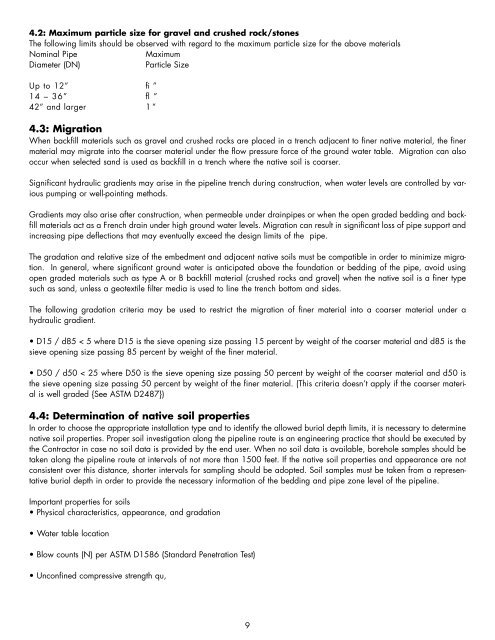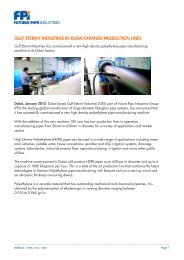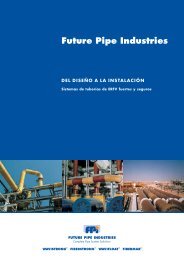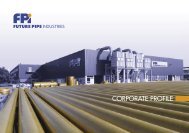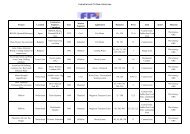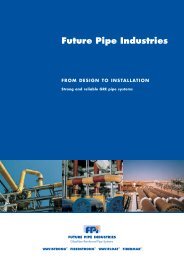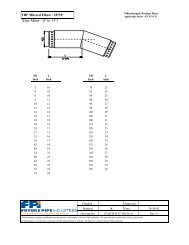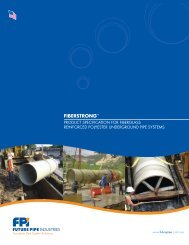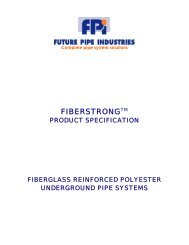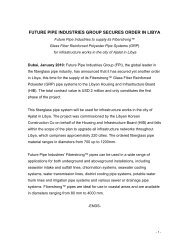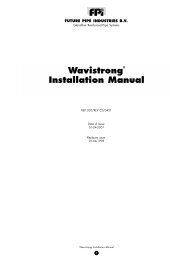Untitled - Future Pipe Industries
Untitled - Future Pipe Industries
Untitled - Future Pipe Industries
You also want an ePaper? Increase the reach of your titles
YUMPU automatically turns print PDFs into web optimized ePapers that Google loves.
4.2: Maximum particle size for gravel and crushed rock/stones<br />
The following limits should be observed with regard to the maximum particle size for the above materials<br />
Nominal <strong>Pipe</strong> Maximum<br />
Diameter (DN) Particle Size<br />
Up to 12” fi ”<br />
14 – 36” fl ”<br />
42” and larger 1 ”<br />
4.3: Migration<br />
When backfill materials such as gravel and crushed rocks are placed in a trench adjacent to finer native material, the finer<br />
material may migrate into the coarser material under the flow pressure force of the ground water table. Migration can also<br />
occur when selected sand is used as backfill in a trench where the native soil is coarser.<br />
Significant hydraulic gradients may arise in the pipeline trench during construction, when water levels are controlled by various<br />
pumping or well-pointing methods.<br />
Gradients may also arise after construction, when permeable under drainpipes or when the open graded bedding and backfill<br />
materials act as a French drain under high ground water levels. Migration can result in significant loss of pipe support and<br />
increasing pipe deflections that may eventually exceed the design limits of the pipe.<br />
The gradation and relative size of the embedment and adjacent native soils must be compatible in order to minimize migration.<br />
In general, where significant ground water is anticipated above the foundation or bedding of the pipe, avoid using<br />
open graded materials such as type A or B backfill material (crushed rocks and gravel) when the native soil is a finer type<br />
such as sand, unless a geotextile filter media is used to line the trench bottom and sides.<br />
The following gradation criteria may be used to restrict the migration of finer material into a coarser material under a<br />
hydraulic gradient.<br />
• D15 / d85 < 5 where D15 is the sieve opening size passing 15 percent by weight of the coarser material and d85 is the<br />
sieve opening size passing 85 percent by weight of the finer material.<br />
• D50 / d50 < 25 where D50 is the sieve opening size passing 50 percent by weight of the coarser material and d50 is<br />
the sieve opening size passing 50 percent by weight of the finer material. (This criteria doesn’t apply if the coarser material<br />
is well graded {See ASTM D2487})<br />
4.4: Determination of native soil properties<br />
In order to choose the appropriate installation type and to identify the allowed burial depth limits, it is necessary to determine<br />
native soil properties. Proper soil investigation along the pipeline route is an engineering practice that should be executed by<br />
the Contractor in case no soil data is provided by the end user. When no soil data is available, borehole samples should be<br />
taken along the pipeline route at intervals of not more than 1500 feet. If the native soil properties and appearance are not<br />
consistent over this distance, shorter intervals for sampling should be adopted. Soil samples must be taken from a representative<br />
burial depth in order to provide the necessary information of the bedding and pipe zone level of the pipeline.<br />
Important properties for soils<br />
• Physical characteristics, appearance, and gradation<br />
• Water table location<br />
• Blow counts (N) per ASTM D1586 (Standard Penetration Test)<br />
• Unconfined compressive strength qu,<br />
9


